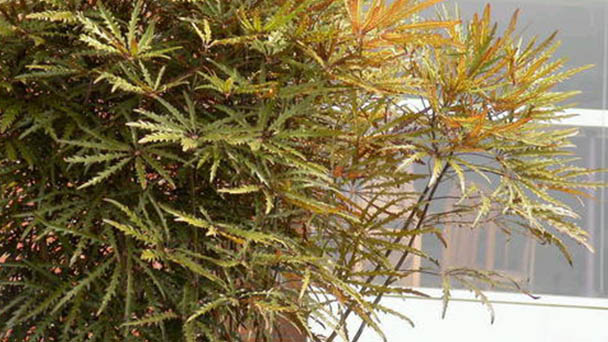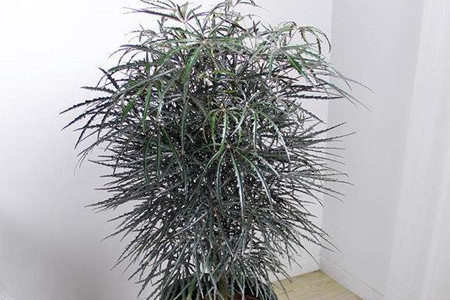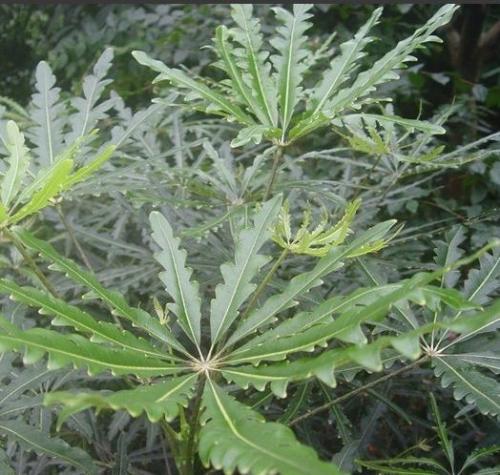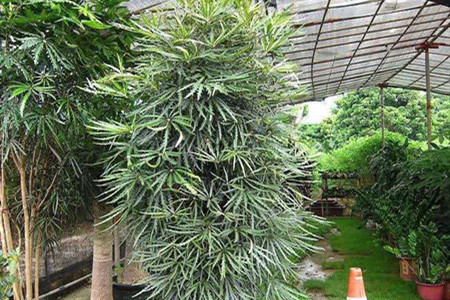False Aralia (Plerandra Elegantissima) Profile: Plant Care & Growing Guide
Written by Maggie
Nov 12 2021

False aralia, scientific name Plerandra elegantissima, also called spider aralia, threadleaf aralia, finger aralia, a small evergreen foliage trees or shrubs of the family Paganaceae in the order Umbelliferae. False aralia is native to Australia and Pacific Islands.Leaves leathery, dark green, elongated fingers, with coarse sawed margins, radiating, crisscrossed.
False Aralia picture

False Aralia info
| Botanical Name | Plerandra elegantissima |
| Common Names | False aralia, spider aralia, threadleaf aralia, finger aralia |
| Plant Type | Evergreen |
| Mature Size | 4–6 ft. tall, 1–2 ft. wide |
| Natural Range | South Pacific |
| Bloom Description | Fall, winter |
| Sun | Full sun to part shade |
| Toxicity | None |
| Flower | Yellow, green, gold |
False Aralia Appearance
False aralia (Plerandra elegantissima) is a small evergreen foliage tree or shrub, often under 2 m in pot. The trunk and petiole have milky white spots. Leaves are alternate, palmate compound leaves, leaflets 7~11, lanceolate, 7-15 cm long, 1-1.5 cm wide, serrated or pinnately divided edge, young leaves purple red, dark green. Leaf veins are brown, the total petiole slender. Complex umbellate inflorescences, in the axils of stem apex leaves, florets yellow green is not significant.
Read More:
12 Popular Evergreen Plants with Pictures for Beginners
False Aralia Ecological Habits
False aralia prefers warm, humid and sunny environments. It is a photophilic plant and does not tolerate cold or direct sunlight. false aralia needs Loose, fertile, well-drained sandy soil rich in organic matter. Give appropriate shade in summer, but more sun in autumn and winter. False aralia is suitable for the temperature of 20°C-29°C. Winter temperature should not be lower than 5℃, special attention to the temperature can not be too high or low, otherwise False aralia vulnerable to freezing damage.
False Aralia Distribution
False aralia (Plerandra elegantissima) is native to Australia and the Polynesian Islands in the Pacific Ocean. False aralia was introduced and cultivated earlier in South China, and now it is introduced as cultivated plants in many areas. India, Sri Lanka and Indo-China Peninsula are also distributed.
False aralia (Plerandra elegantissima), graceful tree and leaf shape, palmately compound leaves, purplish red, leaflets pinnately divided, very elegant, rare and famous plant. False aralia is suitable for potted ornamental, often used in rooms, halls and assembly hall layout.
False Aralia Care
False Aralia Temperature Care
The suitable temperature for growth of False aralia (Plerandra elegantissima) is 18-28°C, 20-28°C from spring to autumn, and 13-20℃ from autumn to spring of the following year. The indoor temperature in winter should not be lower than 10°C, but the adult plants can tolerate low temperatures of about 5°C. In summer, when the temperature reaches more than 30°C, it is necessary to humidify and cool the temperature by building a shed and shading the leaves with water spraying, so as to create a relatively cool environment for False aralia potted plants. Late early winter, when temperatures plunged 13 °C or so, want to move it into indoors, after entering in the indoors, the False aralia potted plants, should care in a relatively stable temperature, avoid by all means is high or low temperature, otherwise the plant will fall a large number of leaves, because of chilling injury, and especially in January 5 to 6 in the morning, must have the special auxiliary heat insulation measures, such as jacketed such as plastic bags, electric heating, make its can there be peace for the winter.
False Aralia Light Requirements
False aralia (Plerandra elegantissima) is more light-loving and can be planted in patches with a little shade from trees. Potted plants can be placed under the shade of conservation in growing period, according to the strength of the light, shading 30%-50%, winter in the shed is not shading.
False Aralia Watering
False aralia (Plerandra elegantissima) requires a wet environment. Spring and autumn two season requirements have sufficient water supply, but watering should see dry see wet, seedlings watering to more frequently; Basin soil is too dry, easy to lead to leaf curl, withered tip or fall off; The basin soil is too wet is not good, easy to cause water rot. False aralia also requires high air humidity. All the year round need to often spray water to the foliage and around the False aralia, so as to increase air humidity, so that it can maintain exuberant growth and yue purpose leaf color luster, otherwise dry air will also cause leaf curl or fall off. In late autumn and early winter, when the temperature drops to 10-13℃, plants stop growing and enter dormant state, and watering should be controlled. After entering the winter basin soil appropriately maintains moist, or with sprinkled water generation. But when spraying water, the water temperature should be kept basically the same as the temperature of the shed, and cold water should not be stimulated.

False Aralia Fertilizer
False Aralia (Plerandra elegantissima) prefers fat. Productive cultivation: growing season can be poured every 20 days 1 times the thin cake fertilizer water; For family planting, a small amount of multiple compound fertilizer particles can be regularly scattered or buried in the basin soil, and a mixture of 0.2% urea and 0.1% potassium dihydrogen phosphate can also be poured. Fertilization should be suspended in midsummer when the temperature is above 30℃. The cold resistance of False aralia can be increased by applying low concentration of fast potash fertilizer once or twice in autumn, such as 0.2% potassium dihydrogen phosphate solution. In late autumn and early winter, when the temperature drops to 10-13°C, all forms of top dressing should be stopped. When its leaves appear physiological yellowing, it can be properly poured or sprayed with 0.2% ferrous sulfate solution, which can effectively restrain the plant leaves yellowing and make the newly pumped leaves appear vibrant green.
False aralia is fond of humus loam, and it is best to make culture soil with leaf rot soil, garden soil and river sand mixture.
False Aralia Pruning
Too delicate weak False Aralia plant, can undertake heavy pruning when new leaf germination, base stays 10 cm or so, as above branch is dry also appropriate strong cut, in order to promote branches and leaves.
False Aralia Repotting
False aralia (Plerandra elegantissima) is not especially fast-growing and has relatively low nutritional requirements, so will likely only need to be repotted every other year. It also prefers to be a bit root-bound and cozy in a smaller-than-average pot, so don't go too oversized when initially planting (and don't rush to size up if you notice the plant looking a bit snug). The best argument for regular repotting is to preserve the drainage qualities of your original potting media. When repotting, resist the urge to separate clumped plants—it will only damage the root ball.
False Aralia propagation
Sow Propagation
In parts of southern China, seeds and seedlings can be sown. Seeds of False aralia (Plerandra elegantissima) should be sown in time after harvesting, otherwise the seeds will lose their germinating ability due to poor storage. The seeds can be cleaned first, stored in wet sand, to be split after white sowing, spring sowing, germination of seeds suitable temperature for 20-25℃, about 25-30 days after sowing can emerge. The germination rate will be seriously affected at low temperature.In addition, variegated varieties should not be used to sow seedlings.
Cuttings Propagation
In the greenhouse, the cutting propagation of False aralia can be carried out in spring and autumn. Cuttage substrate available froganite, perlite, peat soil, rice chaff ash can also be used to drench 2 alkaline rice chaff ash and 1 wet sand, prepared into a mixed substrate: in the condition of electric hot bed cut under the cuttings with a concentration of 500mg/ L indole-butyric acid or No. 1 ABT root powder treatment 5-10s, the rooting effect is more ideal. The length of the cuttings is 10-15cm, 1-2 leaves at the base are cut off, and the insertion depth is about 1/2 of the length of the cuttings. After the spray is permeable, the bamboo bow is set up, the film is covered with moisture, and the shade is given appropriately. The proper rooting temperature is maintained at 20-25 °C, and the root can be rooted in about 20 days.
Layering Propagation
Plant clumps on the ground, low pressure available in SPRING: high pressure is available on taller potted plants. Because of False aralia (Plerandra elegantissima) thin stem, when high pressure is carried out, a bamboo pole should be inserted first, and the soil mass of the layering part should be tied against the bamboo pole.
False Aralia Disease Control
False aralia (Plerandra elegantissima) is susceptible to leaf spot and anthrax and can be treated with 500 times of 50% tobuzine WP.
When the air is too dry, it is easy to harm the leaves by scale insects. It should be checked in time, removed manually or sprayed with oxidized dimethoate for prevention and control.
Spring, summer trade by red spider harm, to strengthen ventilation and early prevention.

Latest Updated
- Benefits of Bugleweed - 7 Science-backed Health Benefits
- Bugleweed Dangers & Side Effects - Is It Poisonous?
- How to Plant Evergreen Trees - What You Should Know
- When to Plant Evergreens - Grow Guide for Evergreen Trees
- 12 Wonderful Evergreen Shrubs for Your Garden
- 12 Popular Evergreen Plants with Pictures for Beginners
- When And How To Prune A Lilac Bush Like a Pro
- How to Grow & Care for Lilac Vine (Hardenbergia Violacea)
- Japanese Lilac Tree (Syringa Reticulata) Care & Propagation Guide
- Shumard Oak Pros and Cons - What to Know
Popular Articles
- Winter maintenance of Antirrhinum Majus
- How to Grow Terminalia Mantaly Tree
- How to Grow and Care for Crossostephium Chinense
- How to grow Antirrhinum Majus in spring
- Peristeria Elata (Dove Orchid) Profile: Info & Care Guide
- Underwatered Snake Plant (Sansevieria Trifasciata) - Signs And How To Fix
- How to Care for Brazilian Jasmine Plant (Mandevilla Sanderi)
- How to Grow & Care for Graptopetalum Purple Delight in Summer
- Rosa Chinensis (China Rose): Plant Growing & Care Tips
- How to Care for Baby Sun Rose (Aptenia Cordifolia)